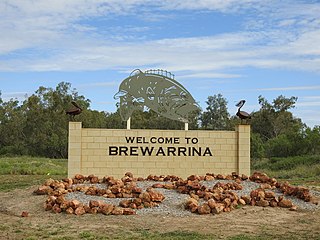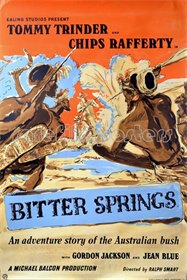Related Research Articles

Brewarrina is a town in north-west New South Wales, Australia on the banks of the Barwon River in Brewarrina Shire. The name Brewarrina is derived from 'burru waranha', a Weilwan name for a species of Acacia, Cassia tree, "Acacia clumps", "a native standing" or "place where wild gooseberry grows". It is 96 kilometres (60 mi) east of Bourke and west of Walgett on the Kamilaroi Highway, and 787km from Sydney. The population of Brewarrina in 2016 was 1,143. Other towns and villages in the Brewarrina district include: Goodooga, Gongolgon, Weilmoringle and Angledool.

Bitter Springs is a 1950 Australian–British film directed by Ralph Smart. An Australian pioneer family leases a piece of land from the government in the Australian outback in 1900 and hires two inexperienced British men as drovers. Problems with local Aboriginal people arise over the possession of a waterhole. Much of the film was shot on location in the Flinders Ranges in South Australia
Alfred Rolfe, real name Alfred Roker, was an Australian stage and film director and actor, best known for being the son-in-law of the celebrated actor-manager Alfred Dampier, with whom he appeared frequently on stage, and for his prolific output as a director during Australia's silent era, including Captain Midnight, the Bush King (1911), Captain Starlight, or Gentleman of the Road (1911) and The Hero of the Dardanelles (1915). Only one of his films as director survives today.
The Lady Outlaw is a 1911 Australian silent film set in Van Diemen's Land during convict days.
What Women Suffer is a 1911 Australian silent film directed by Alfred Rolfe. It is a Victorian melodrama, complete with a climax where a little child is placed on a moving saw bench and is considered a lost film.
Caloola, or The Adventures of a Jackeroo is a 1911 Australian silent film directed by Alfred Rolfe based on a novel published the previous year by Clement Pratt.
King of the Coiners is a 1912 Australian silent film directed by Alfred Rolfe. It is considered a lost film.
Do Men Love Women? is a 1912 Australian silent film directed by Alfred Rolfe about an alcoholic who reforms through the love of a good woman. The finale featured a railway collision.
The Sin of a Woman is a 1912 Australian silent film directed by Alfred Rolfe.
Moira, or The Mystery of the Bush is a 1912 Australian silent film directed by Alfred Rolfe.
Charles Villiers was an Australian actor and occasional director who appeared in many silent films. According to a contemporary report, "there is probably no actor in Australia that has done more consistent picture work than Mr. Villiers, both as heavy lead, and director." He was particularly well known for playing villains.
The Life of a Jackeroo is a 1912 Australian silent film directed by Franklyn Barrett. It is considered a lost film.
Bushranger's Ransom, or A Ride for Life is an Australian film starring the Bohemia Dramatic Company of E. I. Cole. It is adapted from a stage play about a real-life raid by bushranger Ben Hall on the Keightley household near Bathurst in 1863.
For Australia is a 1915 Australian silent film directed by Monte Luke.
The Australian Photo-Play Company was a short-lived but highly productive Australian film production company which operated from 1911 to 1912.

How We Fought the Emden is a 1915 Australian silent film directed by Alfred Rolfe about the Battle of Cocos during World War I. It features footage shot on Cocos Island.

Stanley Walpole was an Australian actor of stage and screen who was one of the first Australians have success in American films.
A Man – That's All (1916) is an Australian war film directed by Alfred Rolfe for Australasian Films.
The New South Wales Aborigines Protection Association, also known as NSW Aborigines Protection Association, Association for the Protection of Aborigines, Aborigines Protection Association and Aboriginal Protection Association, was a private body which supported Aboriginal Australians in New South Wales, Australia. Specifically, it administered Maloga Mission until the residents moved to Cumeroogunga, and the mission stations at Warangesda and Brewarrina.
References
- 1 2 "THEATRICAL TIT-BITS". Sydney Sportsman . Surry Hills, NSW. 26 July 1911. p. 3. Retrieved 20 February 2015– via National Library of Australia.
- ↑ "Advertising". The Cumberland Argus and Fruitgrowers' Advocate . Parramatta, NSW. 12 August 1911. p. 12. Retrieved 9 November 2014– via National Library of Australia.
- ↑ Vagg, Stephen (25 May 2020). "The A to Z of Non-White Aussie Movies and TV in White Australia". Filmink.
- ↑ "BIJOU PICTURES". Goulburn Evening Penny Post . NSW. 12 September 1911. p. 2. Retrieved 9 November 2014– via National Library of Australia.
- ↑ Vagg, S., & Reynaud, D. (2016). Alfred Rolfe: Forgotten pioneer Australian film director. Studies in Australasian Cinema, 10(2),184-198. doi:10.1080/17503175.2016.1170950
- ↑ "Lyric Theatre, Prahran". Malvern Standard . Vic. 12 August 1911. p. 3. Retrieved 26 February 2012– via National Library of Australia.
- 1 2 Andrew Pike and Ross Cooper, Australian Film 1900–1977: A Guide to Feature Film Production, Melbourne: Oxford University Press, 1998, 21
- ↑ "WEST'S PICTURES". Gippsland Times (MORNINGS. ed.). Vic. 21 December 1911. p. 3. Retrieved 22 February 2012– via National Library of Australia.
- 1 2 "MOVIE "HEAVY" CHATS LIGHTLY". Winner . Melbourne. 22 December 1915. p. 12. Retrieved 15 November 2014– via National Library of Australia.
- ↑ "THE MOVING PICTURE WORLD". The Referee . Sydney. 5 July 1911. p. 16. Retrieved 19 November 2014– via National Library of Australia.
- ↑ "FILM-MAKING IN AUSTRALIA". The Advertiser . Adelaide. 11 June 1936. p. 11. Retrieved 21 November 2014– via National Library of Australia.
- ↑ "WEST'S PICTURES". Williamstown Chronicle . Vic. 6 January 1912. p. 2. Retrieved 14 September 2013– via National Library of Australia.
- ↑ "Advertising". The Advertiser . Adelaide. 19 August 1911. p. 20. Retrieved 9 November 2014– via National Library of Australia.